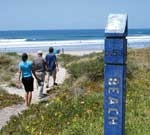PDF of this article (130 KB)


Growing up in Raglan, in the midst of a family famous for its commitment to values of conservation and community service, Darcel Rickard has always known that the coast would figure in her future. Her grandmother Eva led the successful battle to reclaim for their hapu the Raglan land that was confiscated during World War II and is now the site of the Kokiri Centre. Her grandfather Tex has for years run various educational schemes at the centre, including beach–care programmes aimed at restoring dunes using branch–and–brush fascines and dune planting. Darcel’s interests and work are natural outgrowths of her background, and her goal is to bring new understanding back to her flax roots.
W&A – What are your tribal affiliations?
Darcel – My nana was born and bred in Raglan, but she also has tribal connections to the Nelson area through Ngāti Koata, and my grandpa comes from the East Cape north of Gisborne, so that’s Ngāti Porou. I was brought up in Raglan just a stone’s throw from the sea at Te Kopua, the ancestral land of my father’s people.
Ko Karioi te maunga Ko Whāingaroa te moana Ko Whareiaia te tangata Ko Ngāti Tahinga te iwi
W&A – How did you come to be a beach scientist?
Darcel– I always wanted to get a job doing something related to the sea, which I guess comes naturally from my upbringing next to the coast. Growing up immersed in my Māori culture and beliefs, I’ve always had this strong connection with the sea and the environment. Even as youngsters, we were taken out on to the beach and foreshore and taught about our environmental surroundings. I went to Raglan Area School and studied mostly chemistry, biology, maths, and Te Reo Māori, including doing some university Māori papers.
After Sixth Form my options for further education at Raglan Area School were rather limited, so I enrolled at the University of Waikato. I was planning to do a BA in Māori and also a little bit of science, because that was what I was good at in school. But it turned out that I enjoyed science so much that I switched to a BSc with Māori as my supporting major.
W&A – Which led to your job at NIWA. What does your work here involve?

Darcel – I ended up with a double major in earth sciences and Māori, with a focus on environmental monitoring and coastal geomorphology and management. Just as I was finishing my degree, I heard that NIWA was looking for a Māori coastal researcher.
I started at NIWA in Hamilton in June last year, and since then I’ve worked mainly on two projects. I’ve been analysing Cam-Era images of rip currents at Pauanui and Tairua, looking especially at rip frequency, location, and persistence. We looked at the images from the camera, noted the rips, and then compared what we saw happening with concurrent wave data. Some of this work has ended up in an English and Māori poster that warns about the danger of rip currents. It’s been distributed to surf lifesaving clubs and to different maraes.
My other big job has been helping with NZCoast. This is a GIS-based coastal classification and database that will be served up on the NIWA website to tell people about coastal hazards. My work has involved a lot of data entry for the GIS, and compiling coastal erosion and accretion data. It’s funded through NIWA’s hazards programme and due to go online next year. And, fortunately, I’ll be able to use some of my work on NZCoast as part of my masters thesis.
W&A – So, you’re already working on your next degree?
Darcel – I began an MSc at Waikato in February and I’ve been able to handle the classes and still work part-time at NIWA. It fits together well: for my thesis I’m developing a module that will be part of NZCoast. It’s a tool kit for communities to assess their own beaches. It will be a data-collection kit with checklists of things to look for – like dune vegetation, erosional scarps, build-up of the beach, maybe even beach profiles. After noting down all the details, you’ll be able to load the data in through the NZCoast web page and get back a report card on your beach. There will be a way to archive the data for later comparison and, basically, create a long-term record of the state of health of your beach.
W&A – And what will you do once you finish your masters?
Darcel – Well, ultimately I might go for a PhD, possibly overseas to broaden my experience. But in the near future I want to stay in the area and use my education to help people like my grandpa. Though he has a wealth of knowledge and anecdotal evidence about what works and what doesn’t for protecting and restoring the coast, you really need a bit of Western science when it comes to dealing with district councils and others who must work within the framework of the Resource Management Act.
Find out more about Cam-Era at www.niwa.co.nz/services/cam-era. The rips poster will appear in a future issue of Water & Atmosphere.
